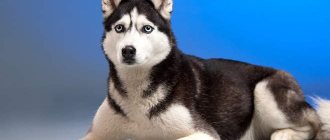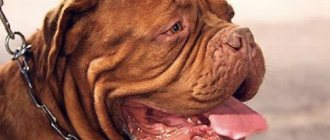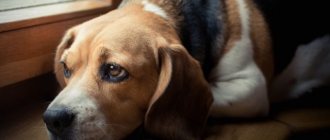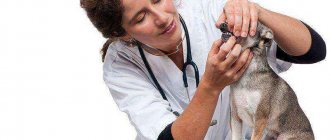Causes and predisposing factors
In most cases, cholecystitis in dogs develops against the background of errors in the nutrition of the four-legged pet. Owners often give animals food from the common table, which negatively affects the digestive tract, the functioning of the gallbladder and liver. Difficult-to-digest substances accumulate, rot, and inflammation develops. With poor outflow of bile and stones, the pathological process intensifies.
Other negative factors associated with feeding your dog:
- cheap food of low quality;
- overfeeding the dog, development of obesity;
- Water is not always freely available when receiving dry food, which leads to digestive problems;
- The diet contains few foods containing vitamin A and beta-carotene. A deficiency of nutrients interferes with the regeneration of liver and gallbladder cells;
- violation of the feeding regime, the dog often goes hungry;
- the animal receives products that pose a threat to the health of the four-legged pet.
External and internal factors provoking the development of cholecystitis:
- parasitic and intestinal infections;
- liver diseases;
- damage to the digestive organs: colitis, ulcers, gastritis, pancreatitis;
- abnormalities in the structure of the gallbladder that interfere with the outflow of secretions;
- viral enteritis;
- cholelithiasis;
- fatty hepatosis (damage to liver cells) due to obesity in a dog;
- prolonged stress;
- severe psycho-emotional state of the dog.
How and with what to treat gum inflammation in a dog? View a selection of effective treatment options.
The signs, characteristic symptoms and effective treatment methods for acanthosis nigricans in dogs are written on this page.
More information about the disease cholecystitis in dogs
The gallbladder serves as a reservoir for bile. A healthy dog's body produces up to 1 ml of fluid per kilogram of live weight. Bile goes to the duodenum, where it participates in the digestive process. When the walls of an organ are damaged, inflammation begins in it, which turns into cholecystitis.
Often this process is combined with cholecystolithiasis, which is characterized by the presence of stones in the pet’s gall bladder. Stagnant processes begin in the organ, which can lead to rupture.
Types of disease
Pathology is divided into several types, which depend on the causes of the disease.
Obstructive cholecystitis. The disease develops due to compression of the bile ducts, liver tumors and other reasons. May occur due to stones in the organ.
Symptoms and signs
Main manifestations of pathology:
- belching;
- loose stools;
- frequent vomiting;
- disruption of the digestive process;
- mucus and, often, bile are visible in the stool;
- flatulence;
- loss of appetite;
- weight loss;
- thirst;
- decreased skin elasticity;
- wool becomes dull;
- dehydration;
- the animal becomes lethargic and inactive;
- pain on palpation of the abdomen;
- yellowish tint of gums;
- orange tint of urine due to increased bilirubin levels.
Acute and chronic cholecystitis
Inflammation of the gallbladder occurs in acute and chronic forms. Each type of pathology is dangerous for the body. With timely and competent treatment of acute cholecystitis, the recurrent course of the disease can be prevented. In severe cases, damage to the gallbladder is so dangerous that there is a possibility of rupture of the organ, requiring immediate surgery.
An exacerbation develops against the background of acholia, signs of jaundice appear. Fever, deterioration in health, blockage of ducts, inflammation in the gallbladder are signs of an acute form of cholecystitis. In severe cases, stones accumulate and the risk of gallbladder rupture increases, which can lead to peritonitis and sepsis. With this development of the situation, urgent surgery is required. The chronic form of the disease does not have pronounced symptoms. The animal’s digestion worsens, stool is disrupted, external signs appear, for example, the coat becomes dull, and dry skin increases. Complications and pain appear during exacerbations of cholecystitis.
Clinical picture of the disease
Since the root causes of the pathology vary greatly, the symptoms of cholestasis in a dog are not particularly uniform. But still, in general terms, the clinical picture is quite similar:
- Jaundice , that is, yellowing of the eyes, skin and mucous membranes. When a sick dog yawns, it seems as if there is a ripe orange in its throat, everything is so yellowed.
- Lethargic or even comatose state. Clearly indicates severe cholemia. If it comes to such symptoms, the chances of recovery are very small.
- Excessive appetite, which is caused by poor absorption of nutrients. When the disease develops, the animal practically stops eating.
- Blood clotting worsens , even small scratches begin to bleed excessively.
- Weight loss , which also develops gradually.
- The feces become pale and even white . The fact is that the color of normal stool is due to stercobilin, a derivative of bilirubin (which, in turn, is a bile acid). There is no bile in the intestinal lumen - no stercobilin.
- Orange urine . On the contrary, when a lot of bile appears in the blood, it is massively excreted through the kidneys. For the latter, this is a severe blow; over time, kidney failure develops.
Diagnostics
If an inflammatory process in the gallbladder is suspected, the veterinarian will refer the dog for a comprehensive examination. It is important to do a blood, urine and stool test, and an ultrasound of the abdominal organs. Fluoroscopy of the gallbladder provides useful information.
Additional research:
- study of the bacterial and cytological composition of bile after collecting the contents using a fine-needle biopsy;
- scintigraphy is a modern method using a low dose of radionuclides;
- liver biopsy if severe organ damage is suspected;
- laparotomy if signs of peritonitis appear against the background of gallbladder rupture.
Treatment
The nature of therapy depends on the stage of the pathology, the severity of the inflammatory process, its form: acute or chronic, and the development of complications. If there is a threat of peritonitis, a laparotomy is performed - removal of the affected bladder using endoscopic instruments.
Important! The animal receives all medications for acute and chronic forms strictly as prescribed by the veterinarian. The dog must follow a diet not only during treatment, but also after recovery.
General rules
Treatment of cholecystitis will be successful if you follow the recommendations:
- review the diet, switch the dog to a dietary diet. Many super premium and holistic brands have a “Veterinary Diet” line;
- when receiving natural food, you need to exclude all products that irritate the stomach, intestines, liver, and gall bladder;
- Drug therapy should only be carried out as directed by a veterinarian. Do not stop taking medications prematurely, even after severe symptoms disappear;
- treat pathologies that cause inflammation of the gallbladder.
Medicines
Therapy goals:
- normalize the flow of bile;
- suppress pain;
- eliminate the causes of the development of the inflammatory process;
- destroy pathogenic microorganisms when cholecystitis of infectious etiology is detected;
- restore digestion and stool.
The veterinarian prescribes complex drug therapy for the dog:
- choleretic agents. Allohol, hexamethylenetetramine, magnesium sulfate, Holagon give a good effect;
- decoctions of medicinal plants. A decoction of corn silk and immortelle stimulates the flow of bile. All herbs for the treatment of cholecystitis can be brewed and given to the dog only with the permission of a veterinarian;
- elimination of painful spasms. With cholecystitis, the dog often experiences discomfort. After relaxing the walls of the gallbladder, the pain decreases. Effective painkillers for dogs: Atropine sulfate, No-spa. For severe pain, analgesics are added to antispasmodics: Besalol, Baralgin;
- antibiotics. If the infectious nature of cholecystitis is confirmed, an antibacterial agent is selected. Without destroying the pathogenic flora, inflammation progresses, and a severe form of the disease develops with fever, vomiting, and a sharp deterioration in health. Antibiotics from the cephalosporin group are safer for dogs than other groups of drugs. You cannot select antibacterial drugs on your own: many names, for example tetracycline antibiotics, exhibit hepatotoxicity (negatively affect the liver);
- fight against dehydration. To normalize the water-salt balance against the background of diarrhea, intravenous administration of solutions is prescribed: rheopolyglucin, glucose, saline solution. During infusions (drip administration of compounds), substances actively penetrate into the blood, improvement in the condition occurs quite quickly;
- hepatoprotectors to protect the liver. With cholecystitis, the functioning of an important organ is often disrupted and hepatocytes are damaged. If indicated, the veterinarian prescribes capsules and tablets Essentiale, LIV-52, Heptral;
- physiotherapeutic procedures (not in the acute phase) are prescribed to activate blood circulation, reduce pain, and relax the walls of the gallbladder. Heat exposure is carried out in a veterinary clinic after examining the animal.
When parasitic infections are detected, it is imperative to drive away worms or destroy protozoa in the cells of the liver, blood, and heart muscle. Some worms settle in the lungs, brain, eyes, and not just in the intestines. For deworming, effective drugs are used to combat cestodias and nematodes: Pratel, Ivermek, Pirantel, Trontsil, Milprazone. Maintenance therapy and detoxification of the body are required to avoid poisoning by decay products after the death of the parasites. The dog receives enterosorbents (Enterosgel), probiotics (FortiFlora, Lactoferon, Lactobifid), liver-protecting compounds (Hepatovet for dogs).
ALT
ALT (ALT) or alanine aminotransferase is a liver enzyme that is involved in the metabolism of amino acids. ALT is found in the liver, kidneys, heart muscle, and skeletal muscles.
When the cells of these organs are destroyed, caused by various pathological processes, ALT is released into the blood of the animal's body. ALT norm in the blood of cats and dogs: 1.6-7.6 IU
1. Increased ALT is a sign of serious diseases:
a) toxic liver damage
b) cirrhosis of the liver
c) liver tumor
d) toxic effect on the liver of drugs (antibiotics, etc.)
e) heart failure
f) pancreatitis
g) shock
h) burns
i) trauma and necrosis of skeletal muscles
2. A decrease in ALT levels is observed when:
a) severe liver diseases - necrosis, cirrhosis (with a decrease in the number of cells synthesizing ALT)
b) vitamin B6 deficiency.
Diet and nutrition correction
Therapeutic nutrition is an important element in normalizing the functions of the gallbladder. The optimal type of diet is suggested by the veterinarian observing the pet. Many doctors recommend giving your four-legged pet natural food instead of dry food until the dog recovers, or you need to urgently stop cheap granular food and switch to elite items from the medicinal series for dogs with sensitive digestion.
Basic rules of nutrition for cholecystitis:
- Food is pureed, warm, without adding spices.
- Portions are small to avoid stagnation and increased inflammation.
- Dry food categories allowed are “holistic” and the “Veterinary diet” line (super premium class). The food brands Orijen, Brit, Akana, Gou, and Monge are of high quality.
- Eating several times a day: this makes it easier for the liver and gall bladder to process small amounts of food.
- In case of exacerbation, be sure to undergo a 12-hour fast.
- Lean meat and dietary poultry, such as turkey, are beneficial.
- Buckwheat and rice porridge contain many vitamins and minerals, but do not overload the liver and gall bladder, and are well absorbed.
- Boiled pumpkin and carrots (puree) are useful vegetables for dogs.
- The dog should receive fermented milk products (only low-fat), eggs, cottage cheese.
Check out an overview of the flavors and variety of Pedigree food lines for puppies and adult dogs of small breeds.
A description of the American Eskimo dog breed and the features of its maintenance can be seen in this article.
After clicking on the link, you can learn about why a dog steals food from the table and how to wean your pet from a bad habit.










